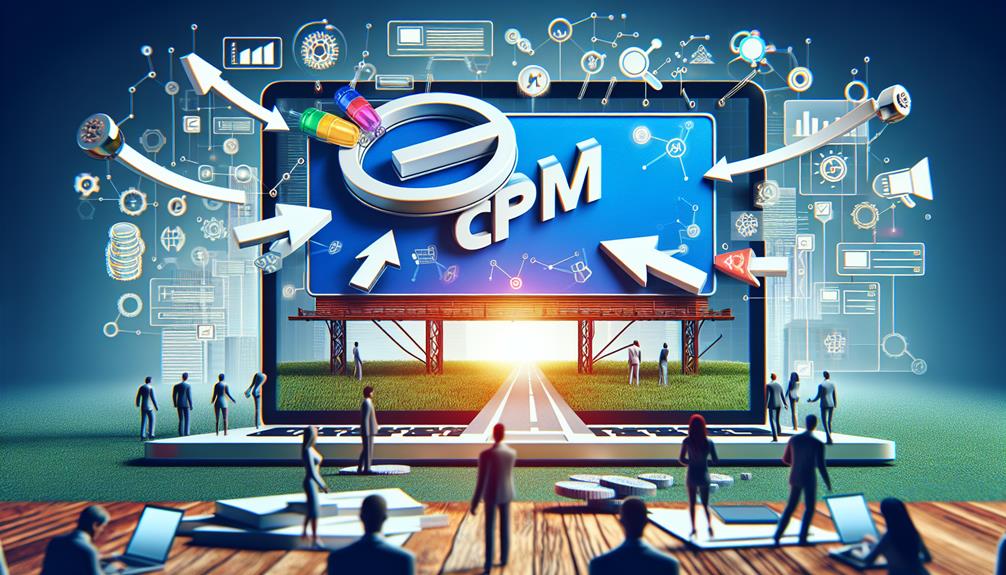Google is making a big change in how they do ads. They’re switching from one way of charging to another. Instead of paying for each click, now they’re going to charge for every thousand views.
This change could really shake things up for people who make money from ads on their websites. It’s important to pay attention to how much money your content brings in. You might be wondering how this switch will affect how much money your website makes and what you should do to keep making money.
Let’s talk about what this change means, how it’s related to what advertisers want, and when it’s happening. Get ready to figure out if this is a good thing or a tough challenge for your website.
New Google AdSense Updates for Publishers

Hey guys, if you’re a publisher, you’re gonna start making money in a new way with Google AdSense. They’re gonna change things up in 2024, so get ready! Instead of getting moolah just from clicks, now you’ll earn cash when people see the ads on your site.
This change is like what’s happening in the ad world, and it’s gonna make it clearer how they figure out your money.
You’ll get 80% of the ad money after they take out some costs, which is more than before. Google says they usually take around 15%, but other places might take more.
Also, they’re switching to this thing called CPM, which is gonna make it easier to compare ads and make it simpler for you to make money from them. Cool, right?
Whoa, I'm not sure this will help with aggressive advertising problems across publishers -> Google AdSense announces it's moving from paying per click to paying per impression
— Glenn Gabe (@glenngabe) November 2, 2023
"It’s important to note that this change will not influence the type or quantity of ads publishers can… pic.twitter.com/OrhHHQCtqd
Reason for AdSense Moving From CPC to CPM

Google AdSense is changing its payment model. Instead of being paid for clicks, website owners will now be paid based on the number of people who see the ads. This change aims to simplify the process of calculating earnings.
Previously, only clicks on ads would generate income. However, with the new model, website owners will earn money for every thousand times an ad is viewed. This change is particularly beneficial for websites that receive high traffic but have low click-through rates.
Google’s objective is to ensure that website owners are compensated fairly for displaying ads on their sites. This will enable them to focus more on creating engaging content for their websites.
Wow, that is a big change
— Peter Pischke-Friendly Neighborhood Journo (@HappyWarriorP) November 2, 2023
So are people going to be charged more for even fewer results?? https://t.co/uNF5p1Trzz
Does the Update Impact Publisher Revenue?

Is the AdSense change going to make publishers earn more or less money? That’s the big question.
The switch from CPC to CPM could make a big difference in how much money websites make from ads. If a website gets a lot of visitors but not many clicks on the ads, they might make more money with the new CPM model.
That’s because they’ll get paid for every thousand times the ad shows up, not just when someone clicks on it.
But if a website’s earnings mainly come from people clicking on the ads, then this change mightn’t be so good for them.
They’ll need to look at how well their website is doing and what their visitors are doing. To make more money, they might need to think about where they put the ads and how good their content is.
It’s important to keep up to date with when the changes will happen and be ready to change strategies.
Google AdSense as the new Taboola.
— Gianluca Fiorelli (@gfiorelli1) November 2, 2023
I think SEOs and Paid Search/Social marketers talk more one each other than the Google Search and AdWords/AdSense teams ???? https://t.co/rydW7efK1s
Does It Affect Advertisers?

Advertisers need to think about how the new CPM model will change their ads and budgets. Even though you can still pick between CPC and CPM, the switch might mean that publishers focus more on getting lots of views rather than clicks.
Google still takes a 15% cut from ads on websites through Google Ads, and if you use other platforms, you should keep an eye on any changes they make because of Google’s updates.
It’s important to stay updated and flexible to handle these changes well.
Yep, considering the HCU now incorporates terrible UX (often based on super aggressive and disruptive ads), the move to impressions will probably not help matters. 🙂 The same goes for broad core updates… But yes, this makes thing consistent with other platforms. pic.twitter.com/HJNoxIRQhr
— Glenn Gabe (@glenngabe) November 2, 2023
When the Update Is Going Live?

Did you know that Google is planning to make some big changes to its AdSense program in early 2024? Instead of the old cost-per-click model, they’re switching to a new CPM model.
It’s super important to get ready for this change and understand how it might affect your ad spending and where your ads get placed.
@adsliaison might be able to clear things up.
— Glenn Gabe (@glenngabe) November 2, 2023
Demanding Simplification and Transparency

If you use Google AdSense, things are changing to a CPM model. This means you’ll get 80% of the money from ads after some deductions.
It’s important to know that you’ll get paid based on how many times the ads are seen, not just if people click on them. This might make it easier to guess how much money you’ll make.
Just remember, other companies can also affect how much money you get from ads, so it’s good to keep up with the news and be ready to adjust to these changes.
What is the difference between CPC and CPM advertising models?
| Criteria | CPC (Cost Per Click) | CPM (Cost Per Mille) |
|---|---|---|
| Billing Method | Pay per click (each user click) | Pay per thousand impressions |
| Payment Structure | Advertiser pays for clicks | Advertiser pays for impressions |
| Goal | Direct response, focused on clicks | Brand awareness, exposure |
| Risk | Lower risk – payment for clicks | Higher risk – payment for impressions |
| Ad Placement | Typically used for performance-based campaigns | Often used for display advertising and brand exposure |
| Common Platforms | Google Ads, Bing Ads, Facebook Ads | Display networks, social media ads |
CPC (Cost Per Click) and CPM (Cost Per Mille) are two common online advertising models with distinct billing methods and goals. CPC charges advertisers for each click on their ad, making it suitable for direct-response campaigns.
In contrast, CPM charges per thousand impressions, making it ideal for brand exposure and awareness. Advertisers should consider factors like campaign goals, risk tolerance, and the desired outcome when choosing between these models.
What are the advantages of each model?
Advantages of CPC (Cost Per Click) Advertising:
- Performance-Based: Advertisers only pay when users click on the ad, ensuring that the cost is directly tied to user engagement.
- Measurable ROI: CPC provides a clear measure of return on investment (ROI) as advertisers can track the number of clicks and assess the effectiveness of their campaigns.
- Direct Response: Ideal for campaigns focused on immediate actions, such as lead generation, conversions, or sales.
- Budget Control: Advertisers have better control over their budget since they are billed based on actual clicks rather than impressions.
- Targeted Traffic: CPC allows advertisers to target specific audiences, ensuring that the budget is spent on users more likely to take the desired action.
Advantages of CPM (Cost Per Mille) Advertising:
- Brand Exposure: CPM is effective for brand awareness and exposure, as advertisers pay for the number of impressions, regardless of clicks.
- Wider Reach: Suitable for campaigns aiming to reach a broader audience, especially when the goal is to increase brand visibility.
- Cost-Efficiency for Impressions: If a campaign generates a high click-through rate (CTR), CPM can be more cost-efficient for achieving a large number of impressions.
- Campaign Visibility: Advertisers can maximize visibility without worrying about click-through rates, making it suitable for visual or display-focused campaigns.
- Ideal for Display Ads: CPM is commonly used for display advertising, where the emphasis is on visuals and creating an impact.
Choosing between CPC and CPM depends on campaign objectives. CPC is suitable for performance-driven goals, while CPM is effective for brand awareness and broader reach campaigns.
What are the debates around CPC and CPM models?
Debates around CPC (Cost Per Click) Model:
- Click Fraud Concerns: One major debate involves click fraud, where malicious entities or competitors may click on ads with the intention of depleting an advertiser’s budget without genuine interest. This raises concerns about the accuracy of click-based metrics.
- Quality of Clicks: Critics argue that the CPC model may not always guarantee high-quality clicks, as users may click without genuine interest in the product or service. This could impact the conversion rate and overall return on investment.
- Short-Term Focus: Some critics argue that CPC can lead to a short-term focus on immediate clicks and conversions, potentially neglecting the long-term benefits of brand exposure and awareness.
Debates around CPM (Cost Per Mille) Model:
- Impression Fraud Concerns: Similar to click fraud, there are concerns about impression fraud in CPM advertising, where fraudulent practices artificially inflate the number of impressions, impacting the accuracy of measurement.
- CTR vs. Brand Impact: Critics argue that prioritizing CPM may downplay the importance of click-through rates (CTR) and user engagement, potentially overlooking the direct response benefits associated with clicks.
- Limited Performance Tracking: Some advertisers debate the limited performance tracking in CPM, as it does not guarantee user interaction. Advertisers paying for impressions may question the effectiveness of their campaigns without clear metrics tied to user actions.
- Potential for Ad Viewability Issues: Ad viewability may be a concern in CPM campaigns, as advertisers pay for impressions regardless of whether users actually see or engage with the ad.
Ultimately, the debates around CPC and CPM models revolve around issues of fraud, quality metrics, and the balance between short-term performance and long-term brand impact.
Advertisers must carefully consider their goals, target audience, and the nature of their products or services when choosing between these models.
Do you believe Google here?
Here is more from the community at WebmasterWorld and X:
Looks like they will no longer show ctr or cpc… Hiding stats is never a good sign for the publishers. That is what they are doing regardless of how they frame it.
they’re doing this either to make a bit more money or a bit less money.
a shiny dollar to the first person to guess the correct option.
I think the bottom line is it will make more money for Google, or they would not be making the change.
I don’t get tons of traffic but I have a high RPM so it all works out. If I get paid the same as I do now, fine. If I get paid some lower random CPM based on category or astrology signs or whatever, then not fine. Just wait and see, I suppose.
I have a really bad feeling about this.
My main concern is that we’ve spent a lot of time over the years trying to find an optimal user experience with ad placements and have done really well with such a limited number of ads but pretty good engagement/CTR surrounded by high quality content. Targeting is usually pretty spot on, too.
Are we going to have to switch from a great user experience to just filling up the page with ads without having to think of where they may provide advertiser value?
I really can’t see how this is helpful to advertisers or publishers nor how it helps AdSense’s competitive advantage over the countless other networks.
It’s probably the first time in 20 or so years that I’m actually thinking seriously about finding an alternative to AdSense. I’ve given some other networks a go, but mainly CPM-based and never came close to what AdSense has done for us.
Google AdSense is changing how it earns money. Instead of getting paid for clicks, now it’s all about getting paid for showing ads. This means you can expect to make money more regularly.
The ad world is getting simpler and more open, and this change is part of that. Keep an eye out for the new way of doing things and get ready to make the most of it.
This is a big change for online publishing, and you’re right at the front of it. Get ready for the change and see your money grow.





![8 Ways to Use ChatGPT for SEO [With Prompt]](https://surprise-media.com/wp-content/uploads/2023/11/Ways-to-Use-ChatGPT-for-SEO-With-Prompt-300x300.jpg)
